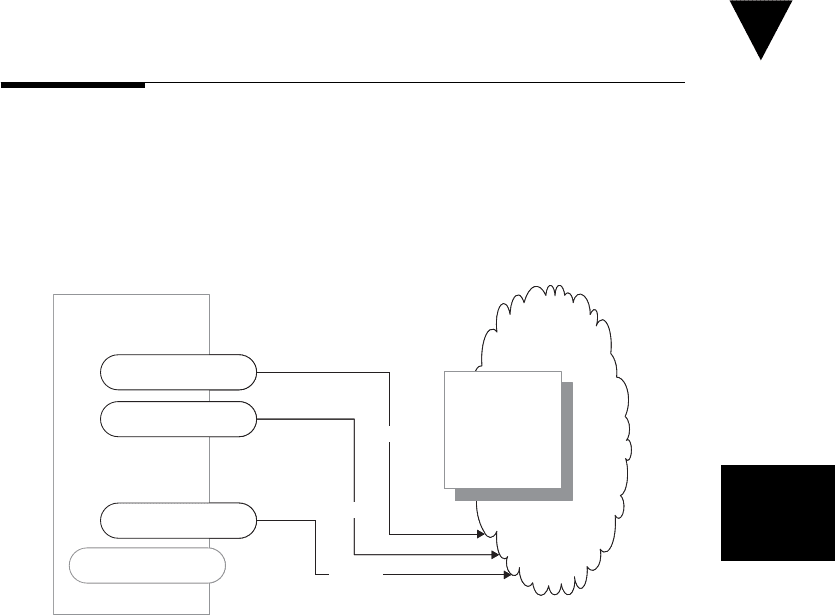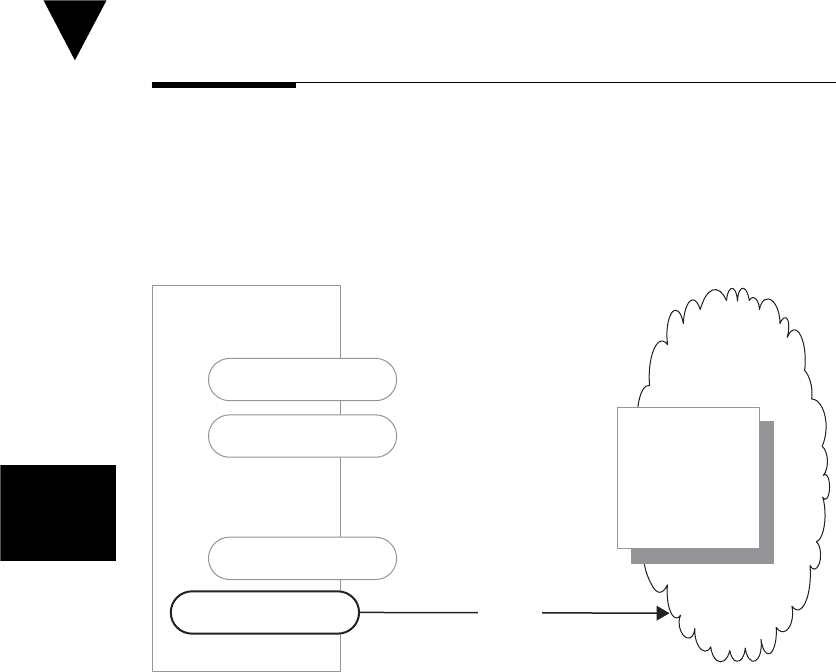Meszaros G. xUnit Test Patterns Refactoring Test Code
Подождите немного. Документ загружается.


508
Chapter 22 Fixture Teardown Patterns
by all Testcase Classes, and would use a generic object destruction mechanism
so that it would not have to care what types of objects it was deleting.
protected void tearDown() throws Exception {
removeObjects(allAirportIds, "Airport");
removeObjects(allFlights, "Flight");
}
public void removeObjects(List objectsToDelete, String type) {
Iterator i = objectsToDelete.iterator();
while (i.hasNext()) {
try {
BigDecimal id = (BigDecimal) i.next();
if ("Airport"==type) {
facade.removeAirport(id);
} else {
facade.removeFlight(id);
}
} catch (Exception e) {
// do nothing if the remove failed
}
}
}
If we were tearing down a Shared Fixture, we would annotate our tearDown method
with the suitable annotation or attribute (e.g., @afterClass or [TestFixtureTearDown])
or move it to a Setup Decorator.
Example: Automated Exercise Teardown
If we wanted to take the next step and automatically tear down any objects
created within the SUT, we could modify the SUT to use an observable Object
Factory. In our test, we would add the following code:
ResourceTracker tracker;
public void setUp() {
tracker = new ResourceTracker();
ObjectFactory.addObserver(tracker);
}
public void tearDown() {
tracker.cleanup();
ObjectFactory.removeObserver(tracker);
}
This last example assumes that the Automated Teardown logic has been moved
into the cleanup method on the ResourceTracker.
Automated
Teardown

509
In-line Teardown
How do we tear down the Test Fixture?
We include teardown logic at the end of the Test Method immediately after the
result verifi cation.
A large part of making tests repeatable and robust is ensuring that the test fi xture
is torn down after each test and a new one created for the next test run. This
strategy is known as a Fresh Fixture (page 311). Leftover objects and database
records, as well as open fi les and connections, can at best cause performance
degradations and at worst cause tests to fail or systems to crash. While some of
these resources may be cleaned up automatically by garbage collection, others
may be left hanging if they are not torn down explicitly.
At a minimum, we should write In-line Teardown code that cleans up
resources left over after our test.
How It Works
As we write a test, we mentally keep track of all objects the test creates that
will not be cleaned up automatically. After writing the code to exercise the SUT
and verify the outcome, we add logic to the end of the Test Method (page 348)
to destroy any objects that will not be cleaned up automatically by the garbage
collector. We use the relevant language feature to ensure that the teardown code
is run regardless of the outcome of the test.
Fixture
SUT
Teardown
Testcase Class
tearDown
test_method_1
test_method_2
test_method_n
Teardown
Teardown
Fixture
SUT
Teardown
Testcase Class
tearDown
test_method_1
test_method_2
test_method_n
Teardown
Teardown
In-line Teardown
In-line
Teardown

510
Chapter 22 Fixture Teardown Patterns
When to Use It
We should use some form of teardown logic whenever we have resources that
will not be freed automatically after the Test Method is run; we can use In-line
Teardown when each test has different objects to clean up. We may discover that
objects need to be cleaned up because we have Unrepeatable Tests (see Erratic
Test on page 228) or Slow Tests (page 253) caused by the accumulation of detritus
from many test runs.
Unlike fi xture setup, the teardown logic is not important from the perspective
of Tests as Documentation (see page 23). Use of any form of teardown logic may
potentially contribute to High Test Maintenance Cost (page 265) and should be
avoided if at all possible. Thus the only real benefi t of including the teardown logic
on an in-line basis is that it may make it easier to maintain the teardown logic—a
pretty slim benefi t, indeed. It is almost always better to strive for Automated Tear-
down (page 503) or to use Implicit Teardown (page 516) if we are using Testcase
Class per Fixture (page 631), where all tests in a Testcase Class (page 373) have the
same test fi xture.
We can also use In-line Teardown as a steppingstone to Implicit Teardown,
thereby following the principle of “the simplest thing that could possibly
work.” First, we learn how to do In-line Teardown for each Test Method; next,
we extract the common logic from those tests into the tearDown method. We
should not use In-line Teardown if the objects created by the test are subject
to automated memory management. In such a case, we should use Garbage-
Collected Teardown (page 500) instead because it is much less error-prone and
keeps the tests easier to understand and maintain.
Implementation Notes
The primary consideration in In-line Teardown is ensuring that the teardown
code actually runs even when the test is failed by an Assertion Method (page 362)
or ends in an error in either the SUT or the Test Method. A secondary consider-
ation is ensuring that the teardown code does not introduce additional errors.
The key to doing In-line Teardown correctly is to use language-level constructs
to ensure that the teardown code is run. Most modern languages include some
sort of error/exception-handling construct that will attempt the execution of a
block of code with the guarantee that a second block of code will be run regard-
less of how the fi rst block terminates. In Java, this construct takes the form of a
try block with an associated fi nally block.
In-line
Teardown

511
Variation: Teardown Guard Clause
To protect against a failure caused by trying to tear down a resource that doesn’t
exist, we can put a “guard clause” around the logic. Its inclusion reduces the
likelihood of a test error caused by the teardown logic.
Variation: Delegated Teardown
We can move much of the teardown logic out of the Test Method by calling a
Test Utility Method (page 599). Although this strategy reduces the amount of
teardown logic cluttering the test, we still need to place an error-handling con-
struct around at least the assertions and the exercising of the SUT to ensure that
it gets called. Using Implicit Teardown is almost always a better solution.
Variation: Naive In-line Teardown
Naive In-line Teardown is what we have when we forget to put the equivalent of
a try/fi nally block around our test logic to ensure that our teardown logic always
executes. It leads to Resource Leakage (see Erratic Test), which in turn may lead
to Erratic Tests.
Motivating Example
The following test creates a persistent object (airport) as part of the fi xture.
Because the object is stored in a database, it is not subject to Garbage-Collected
Teardown and must be explicitly destroyed. If we do not include teardown logic in
the test, each time the test is run it will create another object in the database. This
may lead to Unrepeatable Tests unless the test uses Distinct Generated Values (see
Generated Value on page 723) to ensure that the created objects do not violate any
unique key constraints.
public void testGetFlightsByOriginAirport_NoFlights_ntd()
throws Exception {
// Fixture Setup
BigDecimal outboundAirport = createTestAirport("1OF");
// Exercise System
List flightsAtDestination1 =
facade.getFlightsByOriginAirport(outboundAirport);
// Verify Outcome
assertEquals(0,flightsAtDestination1.size());
}
In-line Teardown
In-line
Teardown

512
Chapter 22 Fixture Teardown Patterns
Example: Naive In-line Teardown
In this naive solution to this problem, we added a line after the assertion to
destroy the airport created in the fi xture setup.
public void testGetFlightsByOriginAirport_NoFlights()
throws Exception {
// Fixture Setup
BigDecimal outboundAirport = createTestAirport("1OF");
// Exercise System
List flightsAtDestination1 =
facade.getFlightsByOriginAirport(outboundAirport);
// Verify Outcome
assertEquals(0,flightsAtDestination1.size());
facade.removeAirport(outboundAirport);
}
Unfortunately, this solution isn’t really adequate because the teardown logic
won’t be exercised if the SUT encounters an error or if the assertions fail. We
could try moving the fi xture cleanup before the assertions but this still wouldn’t
address the issue with errors occurring inside the SUT. Clearly, we need a more
general solution.
Refactoring Notes
We need either to place an error-handling construct around the exercising of the
SUT and the assertions or to move the teardown code into the tearDown method.
Either way, we need to ensure that all the teardown code runs, even if some parts
of it fail. This usually involves the judicious use of try/fi nally control structures
around each step of the teardown process.
Example: In-line Teardown
In this Java example, we have introduced a try/fi nally block around the exercise
SUT and result verifi cation phases of the test to ensure that our teardown code
is run.
public void testGetFlightsByOriginAirport_NoFlights_td()
throws Exception {
// Fixture Setup
BigDecimal outboundAirport = createTestAirport("1OF");
try {
// Exercise System
List flightsAtDestination1 =
facade.getFlightsByOriginAirport(outboundAirport);
// Verify Outcome
assertEquals(0,flightsAtDestination1.size());
In-line
Teardown

513
} finally {
facade.removeAirport(outboundAirport);
}
}
Now the exercising of the SUT and the assertions both appear in the try block
and the teardown logic is found in the fi nally block. This separation is crucial to
making In-line Teardown work properly. We should not include a catch block
unless we are writing an Expected Exception Test (see Test Method).
Example: Teardown Guard Clause
Here, we’ve added a Teardown Guard Clause to the teardown code to ensure it
isn’t run if the airport doesn’t exist:
public void testGetFlightsByOriginAirport_NoFlights_TDGC()
throws Exception {
// Fixture Setup
BigDecimal outboundAirport = createTestAirport("1OF");
try {
// Exercise System
List flightsAtDestination1 =
facade.getFlightsByOriginAirport(outboundAirport);
// Verify Outcome
assertEquals(0,flightsAtDestination1.size());
} finally {
if (outboundAirport!=null) {
facade.removeAirport(outboundAirport);
}
}
}
Example: Multiresource In-line Teardown (Java)
If multiple resources need to be cleaned up in the same test, we must ensure that
all the teardown code runs even if some of the teardown statements contain
errors. This goal can be accomplished by nesting each subsequent teardown step
inside another block of guaranteed code, as in this Java example:
public void testGetFlightsByOrigin_NoInboundFlight_SMRTD()
throws Exception {
// Fixture Setup
BigDecimal outboundAirport = createTestAirport("1OF");
BigDecimal inboundAirport = null;
FlightDto expFlightDto = null;
try {
inboundAirport = createTestAirport("1IF");
expFlightDto = createTestFlight(outboundAirport, inboundAirport);
In-line Teardown
In-line
Teardown

514
Chapter 22 Fixture Teardown Patterns
// Exercise System
List flightsAtDestination1 =
facade.getFlightsByOriginAirport(inboundAirport);
// Verify Outcome
assertEquals(0,flightsAtDestination1.size());
} finally {
try {
facade.removeFlight(expFlightDto.getFlightNumber());
} finally {
try {
facade.removeAirport(inboundAirport);
} finally {
facade.removeAirport(outboundAirport);
}
}
}
}
This scheme gets very messy in a hurry if we must clean up more than a few
resources. In such a situation, it makes more sense to organize the resources into
an array or list and then to iterate over that array or list. At that point we are
halfway to implementing Automated Teardown.
Example: Delegated Teardown
We can also delegate the teardown from within the Test Method if we don’t
believe we can come up with a completely generic way cleanup strategy that will
work for all tests.
public void testGetFlightsByOrigin_NoInboundFlight_DTD()
throws Exception {
// Fixture Setup
BigDecimal outboundAirport = createTestAirport("1OF");
BigDecimal inboundAirport = null;
FlightDto expectedFlightDto = null;
try {
inboundAirport = createTestAirport("1IF");
expectedFlightDto =
createTestFlight( outboundAirport, inboundAirport);
// Exercise System
List flightsAtDestination1 =
facade.getFlightsByOriginAirport(inboundAirport);
// Verify Outcome
assertEquals(0,flightsAtDestination1.size());
} finally {
teardownFlightAndAirports( outboundAirport,
inboundAirport,
expectedFlightDto);
}
}
In-line
Teardown

515
private void teardownFlightAndAirports(
BigDecimal firstAirport,
BigDecimal secondAirport,
FlightDto flightDto)
throws FlightBookingException {
try {
facade.removeFlight( flightDto.getFlightNumber() );
} finally {
try {
facade.removeAirport(secondAirport);
} finally {
facade.removeAirport(firstAirport);
}
}
}
The optimizers among us will notice that the two fl ight numbers are actually
available as attributes of the fl ightDto. The paranoid will counter that because the
teardownFlightAndAirports method could be called before the fl ightDto is constructed,
we cannot count on using it to access the Airports. Hence we must pass the
Airports in individually. The need to think this way is why a generic Automated
Teardown is so attractive; it avoids having to think at all!
In-line Teardown
In-line
Teardown

516
Chapter 22 Fixture Teardown Patterns
Implicit Teardown
How do we tear down the Test Fixture?
The Test Automation Framework calls our cleanup logic in the
tearDown method after every Test Method.
A large part of making tests repeatable and robust is ensuring that the test
fi xture is torn down after each test and a new one created for the next test
run. This strategy is known as a Fresh Fixture (page 311). Leftover objects
and database records, as well as open fi les and connections, can at best cause
performance degradations and at worst cause tests to fail or systems to crash.
When we can’t take advantage of Garbage-Collected Teardown (page 500)
and we have several tests with the same objects to tear down, we can put
the teardown logic into a special tearDown method that the Test Automation
Framework (page 298) calls after each Test Method (page 348) is run.
How It Works
Anything that needs to be cleaned up can be freed or destroyed in the fi nal
phase of the Four-Phase Test (page 358)—namely, the fi xture teardown phase.
Most members of the xUnit family of Test Automation Frameworks support
Implicit
Teardown
Fixture
Testcase Class
SUT
Teardown
test_1
test_2
test_n
Teardown
Also known as:
Hooked
Teardown,
Framework-
Invoked
Teardown,
Teardown
Method

517
the concept of Implicit Teardown, wherein they call the tearDown method of each
Testcase Object (page 382) after the Test Method has been run.
The tearDown method is called regardless of whether the test passes or fails.
This scheme ensures that we have the opportunity to clean up, undisturbed by
any failed assertions. Be aware, however, that many members of the xUnit
family do not call tearDown if the setUp method raises an error.
When to Use It
We can use Implicit Teardown whenever several tests with the same resources need
to be destroyed or freed explicitly after the test has been completed and those
resources will not be destroyed or freed automatically. We may discover this require-
ment because we have Unrepeatable Tests (see Erratic Test on page 228) or Slow
Tests (page 253) caused by the accumulation of detritus from many test runs.
If the objects created by the test are internal resources and subject to automated
memory management, then Garbage-Collected Teardown may eliminate a lot of
work for us. If each test has a completely different set of objects to tear down,
then In-line Teardown (page 509) may be more appropriate. In many cases, we
can completely avoid manually written teardown logic by using Automated Tear-
down (page 503).
Implementation Notes
The teardown logic in the tearDown method is most often created by refactoring
from tests that had In-line Teardown. The tearDown method may need to be
“fl exible” or “accommodating” for several reasons:
• When a test fails or when a test error occurs, the Test Method may not
have created all the fi xture objects.
• If all the Test Methods in the Testcase Class (page 373) don’t use
identical fi xtures,
1
there may be different sets of objects to clean up
for different tests.
Variation: Teardown Guard Clause
We can avoid arbitrarily Conditional Test Logic (page 200) if we deal with the
case where only a subset of the objects to be torn down are actually present by
putting a guard clause (a simple if statement) around each teardown operation
1
That is, they augment the Implicit Teardown with some additional In-line Setup
(page 408) or Delegated Setup (page 411).
Implicit Teardown
Implicit
Teardown
